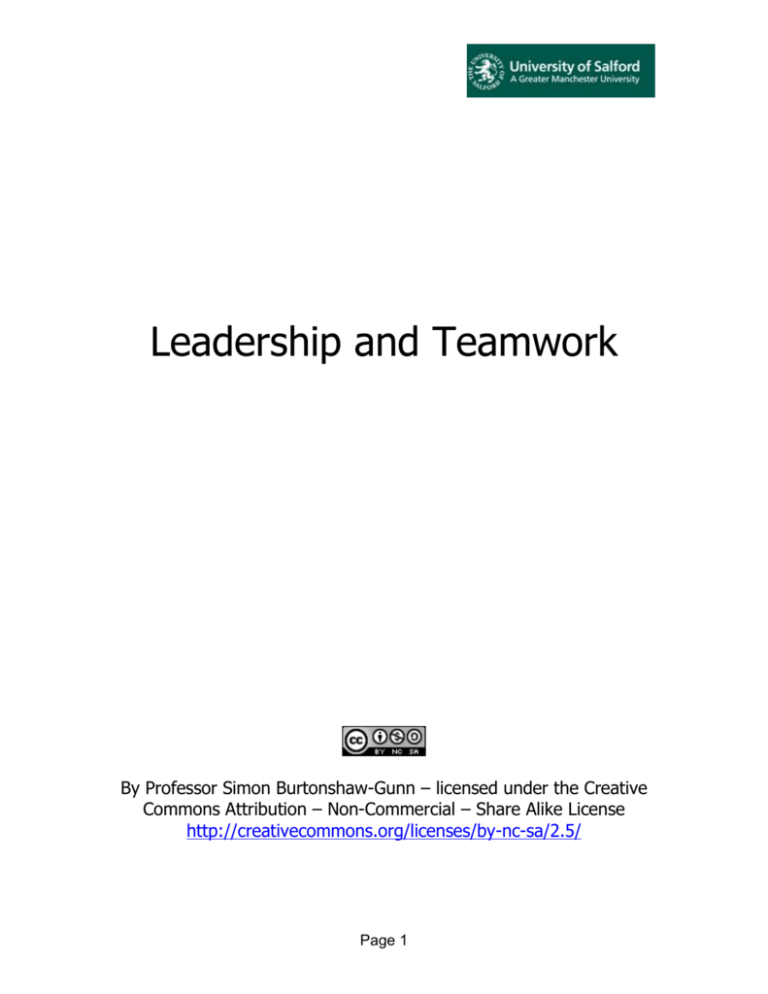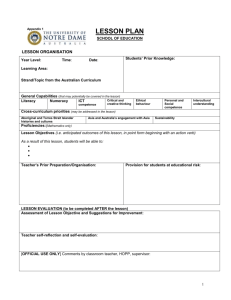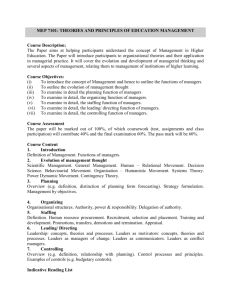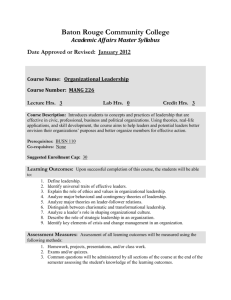1309170719_Basic Theories of Leadership
advertisement

Leadership and Teamwork By Professor Simon Burtonshaw-Gunn – licensed under the Creative Commons Attribution – Non-Commercial – Share Alike License http://creativecommons.org/licenses/by-nc-sa/2.5/ Page 1 Basic Theories of Leadership There are a number of different theories of leadership we need to be aware of. This handout will cover: Trait theories; Behavioural theories; Contingency theories; Transformational leadership; Dispersed leadership; Style theories and Situational theories. TRAIT THEORIES In the 1920's and 1930's, leadership research focused on trying to identify the traits that differentiated leaders from non-leaders. These early leadership theories were content theories, focusing on ‘what’ an effective leader is, not on 'how' to effectively lead. The trait approach to understanding leadership assumes that certain physical, social, and personal characteristics are inherent in leaders, for example: confidence, mental strength, intelligence etc. Sets of traits and characteristics that were identified to assist in selecting the right people to become leaders included: Physical traits included: o o o o Social background traits included: o o being young to middle-aged energetic tall handsome being educated at the ‘right’ schools being socially prominent or upwardly mobile Social characteristics included being: o o o o o charismatic charming tactful popular cooperative Page 2 o Personality traits included being: o o o o diplomatic self-confident adaptable assertive emotionally stable Task-related characteristics included being: o o o o driven to excel accepting of responsibility having initiative being results-oriented There has been quite a lot of research undertaken on trait theory; most of the time the underlying hypotheses have focused on the belief that certain traits make better leaders. In other words they have been trying to ascertain whether or not leaders were born (possessed ideal traits) or were made. There has been very little support for trait theory overall. One interesting piece of work was conducted by Roderick Floud (now Sir Roderick) and focussed upon height of generals in famous battles. Floud managed to get hold of a lot of international historical data about warfare and battles and he found that the average height (males) of a successful battle general was just over six feet two (considerably taller than the average height of a male). This led him to suggest that there was a correlation between successful leadership and height. It was later pointed out to him that a number of other famous battle winning generals such as Bonaparte, Eisenhower and Montgomery were all much shorter than average! BEHAVIOURAL THEORIES The behavioural theorists identified determinants of leadership so that people could be trained to be leaders. They developed training programs to change managers' leadership behaviours and assumed that the best styles of leadership could be learned. Page 3 THEORY X AND THEORY Y – DOUGLAS MCGREGOR Douglas McGregor described Theory X and Theory Y in his book, The Human Side of Enterprise. Theory X and Theory Y each represent different ways in which leaders view employees. Theory X managers believe that employees are motivated mainly by money, are lazy, uncooperative, and have poor work habits. Theory Y managers believe that subordinates work hard, are cooperative, and have positive attitudes. Theory X is the traditional view of direction and control by managers. The average human being has an inherent dislike of work and will avoid if he or she can. Because of this human characteristic of dislike of work, most people must be controlled, directed, and threatened with punishment to get them to put forth adequate effort toward the achievement of organisational objectives. The average human being prefers to be directed, wishes to avoid responsibility, and has relatively little ambition, but wants security above all. Theory X leads naturally to an emphasis on the tactics of control - to procedures and techniques for telling people what to do, for determining whether they are doing it, and for administering rewards and punishment. Theory X explains the consequences of a particular managerial strategy. Because its assumptions are so unnecessarily limiting, it prevents managers from seeing the possibilities inherent in other managerial strategies. As long as the assumptions of Theory X influence managerial strategy, organisations will fail to discover, let alone utilise, the potentialities of the average human being. Theory Y is the view that individual and organisational goals can be integrated. The expenditures of physical and mental effort in work are as natural as play or rest. External control and the threat of punishment are not the only means for bringing out effort toward organisational objectives. Commitment to objectives is a function of the rewards associated with their achievement. Page 4 The average human being learns, under proper conditions, not only to accept but also to seek responsibility. The capacity to exercise a relatively high degree of imagination, ingenuity, and creativity in the solution of organisational problems is widely, not narrowly, distributed in the population. Under the condition of modern industrial life, the intellectual potentialities of the average human being are only partially utilised. Theory Y's purpose is to encourage integration, to create a situation in which an employee can achieve his or her own goals best by directing his or her efforts toward the objectives of the organisation. It is a deliberate attempt to link improvement in managerial competence with the satisfaction of higher level ego and self-actualisation needs. Theory Y leads to a preoccupation with the nature of relationships, with the creation of an environment which will encourage commitment to organisational objectives and which will provide opportunities for the maximum exercise of initiative, ingenuity, and self-direction in achieving them. Theory X is very much associated with the style of management (not leadership) known as Scientific Management as defined by Frederick Taylor and Henry Ford. Theory Y, the humanistic approach is often associated with the Human Relations Approach to management researched extensively by Mayo and Schien amongst others. BLAKE AND MOULTON – THE MANAGEMENT GRID The Managerial Grid is based on two behavioural dimensions: Concern for People – This is the degree to which a leader considers the needs of team members, their interests, and areas of personal development when deciding how best to accomplish a task. This dimension follows the Theory Y or Human Relations Approach. Concern for Production – This is the degree to which a leader emphasizes concrete objectives, organizational efficiency and high productivity when deciding how best to accomplish a task. This dimension follows the Theory X or Scientific Management Approach. Using the axis to plot leadership ‘concerns for production’ versus ‘concerns for people’, Blake and Mouton defined the following five leadership styles: Page 5 Country Club Leadership – High People/Low Production This style of leader is most concerned about the needs and feelings of members of his/her team. These people operate under the assumption that as long as team members are happy and secure then they will work hard. What tends to result is a work environment that is very relaxed and fun but where production suffers due to lack of direction and control. Produce or Perish Leadership – High Production/Low People Also known as Authoritarian or Compliance Leaders, people in this category believe that employees are simply a means to an end. Employee needs are always secondary to the need for efficient and productive workplaces. This type of leader is very autocratic, has strict work rules, policies, and procedures, and views punishment as the most effective means to motivate employees. Impoverished Leadership – Low Production/ Low People This leader is mostly ineffective. They neither have a high regard for creating systems for getting the job done, nor for creating a work environment that is satisfying and motivating. The result is a place of disorganization, dissatisfaction and disharmony. Page 6 Middle-of-the-Road Leadership – Medium Production/Medium People This style seems to be a balance of the two competing concerns. It may at first appear to be an ideal compromise, but there is a problem. When you compromise, you necessarily give away a bit of each concern so that neither production nor people needs are fully met. Leaders who use this style settle for average performance and often believe that this is the most anyone can expect. Team Leadership – High Production/High People According to the Blake Mouton model, this is the pinnacle of managerial style. These leaders stress production needs and the needs of the people equally highly. The premise here is that employees are involved in understanding organisational purpose and determining production needs. When employees are committed to, and have a stake in the organisation’s success, their needs and production needs coincide. This creates a team environment based on trust and respect, which leads to high satisfaction and motivation and, as a result, high production. See also Leadership Assessment handout CONTINGENCY THEORIES Successful leaders must be able to identify clues in an environment and adapt their leader behaviour to meet the needs of their team and of the particular situation. Even with good diagnostic skills, leaders may not be effective unless they can adapt their leadership style to meet the demands of their environment. FIEDLER'S CONTINGENCY MODEL Fred E. Fiedler's contingency theory suggests that there is no best way for managers to lead. Situations will create different leadership style requirements for a manager. The solution to a managerial situation is contingent on the factors that impinge on the situation. For example, in a highly routine environment where repetitive tasks are the norm, a certain leadership style may result in the best performance. The same leadership style may not work in a very dynamic environment. Fiedler looked at three situations that could define the condition of a managerial task: Page 7 Leader member relations: How well do the manager and the employees get along? The task structure: Is the job highly structured, fairly unstructured, or somewhere in between? Position power: How much authority does the manager possess (more on power and authority later)? Managers were rated as to whether they were relationship oriented or task oriented. Task oriented managers tend to do better in situations that have good leader-member relationships, structured tasks, and either weak or strong position power. They do well when the task is unstructured but positional power is strong. Also, they did well at the other end of the spectrum when the leader member relations were moderate to poor and the task was unstructured. Relationship oriented managers do better in all other situations. Thus, a given situation might call for a manager with a different style or a manager who could take on a different style for a different situation. Another aspect of the contingency model theory is that the leadermember relations, task structure, and position power dictate a leader's situational control. Leader-member relations are the amount of loyalty, dependability, and support that the leader receives from employees. It is a measure of how the manager perceives they and the group of employees is getting along together. In a favourable relationship the manager has a high task structure and is able to reward and or punish employees without any problems. In an unfavourable relationship the task is usually unstructured and the leader possesses limited authority. TRANSFORMATIONAL LEADERSHIP Transformational leadership blends the behavioural theories with a little of the trait theories. The key here is to really appreciate the difference between transformational and transactional leaders. Transactional leaders, such as those identified in contingency theories, guide followers in the direction of established goals by clarifying role and task requirements. However, transformational leaders, who are charismatic and visionary, can inspire followers to transcend their own self-interest for the good of the organisation. Transformational leaders appeal to followers' ideals and moral values and inspire them to think about problems in new or different ways. Page 8 Leader behaviours used to influence followers include vision, framing, and impression management. Vision is the ability of the leader to bind people together with an idea. Framing is the process whereby leaders define the purpose of their movement in highly meaningful terms. Impression management is a leader's attempt to control the impressions that others form about the leader by practicing behaviours that make the leader more attractive and appealing to others. Research indicates that transformational, as compared to transactional, leadership is more strongly correlated with lower turnover rates, higher productivity, and higher employee satisfaction. A transformational leader instils feelings of confidence, admiration and commitment in the followers. He or she is charismatic, creating a special bond with followers, articulating a vision with which the followers identify and for which they are willing to work. Each follower is coached, advised, and delegated some authority. The transformational leader stimulates followers intellectually, arousing them to develop new ways to think about problems. The leader uses contingent rewards to positively reinforce performances that are consistent with the leader's wishes. Management is by exception. The leader takes initiative only when there are problems and is not actively involved when things are going well. The transformational leader commits people to action and converts followers into leaders. Transformational leaders are relevant to today's workplace because they are flexible and innovative. While it is important to have leaders with the appropriate orientation defining tasks and managing interrelationships, it is even more important to have leaders who can bring organisations into futures they have not yet imagined. Transformational leadership is the essence of creating and sustaining competitive advantage. TRANSFORMATIONAL Visionary High performance expectations Individual support/individual intellectual stimulation Transcends personal goals Raises expectations and performance TRANSACTIONAL Uses contingent rewards Uses punishment Makes promises for outcomes Action focussed Focuses on short term Page 9 DISPERSED LEADERSHIP There are various views on what dispersed leadership is, but the common ground seems to suggest that it involves: A shared understanding of what leadership means to provide a common base of knowledge and language with which to understand and discuss leadership issues. It opens communication channels allowing for the efficient resolution of organisational issues. This implies that the leadership of an organisation experiences the same training and development so that it establishes a common base of knowledge and language. A commitment to shared goals and values by leaders at all levels of the organisation. Having a strong mission, vision, values and goals helps keep people pulling in the same direction but all must be shared, understood, and accepted at all levels. As leaders at different levels of the organisation do different things, leadership training and development has to be flexible and adaptable for a wide range of leaders, with different needs, at different places in the organisation. It also means that leaders need training whenever they change position. This provides the opportunity to emphasise the mission, vision, values and goals and review their meanings from the leader’s new position. Dispersed leadership requires a means to develop leadership skills and knowledge throughout the organisation as well as a means to determine where the organisation and its individuals are developmentally as leaders. Dispersed leadership requires a formal training program as well as periodic individual and organisation-wide assessments using formal, calibrated instruments. This fosters a culture in which leaders are constantly learning about themselves and their organisation, adapting their behaviours to the needs of both. Page 10 SITUATIONAL LEADERSHIP HERSEY-BLANCHARD SITUATIONAL LEADERSHIP The Hersey-Blanchard Situational Leadership theory is based on the amount of direction (task behaviour) and amount of socio-emotional support (relationship behaviour) a leader must provide given the situation and the "level of maturity" of the followers. Task behaviour is the extent to which the leader engages in spelling out the duties and responsibilities to an individual or group. This behaviour includes telling people what to do, how to do it, when to do it, where to do it, and who's to do it. In task behaviour the leader engages in one-way communication. Relationship behaviour is the extent to which the leader engages in two-way or multi-way communications. This includes listening, facilitating, and supportive behaviours. In relationship behaviour the leader engages in two-way communication by providing support. Maturity is the willingness and ability of a person to take responsibility for directing his or her own behaviour. People tend to have varying degrees of maturity, depending on the specific task, function, or objective that a leader is attempting to accomplish through their efforts. Kenneth Blanchard took another approach when he looked at ‘situational leadership’ by considering leadership in terms of ‘Directive Behaviour’ and ‘Supportive Behaviour’. By combining high and low levels of each type of behaviour we progress towards four distinct styles of leadership: DIRECTING COACHING SUPPORTING DELEGATING The leader provides specific instructions and closely supervises task accomplishment. The leader continues to direct and closely supervise task accomplishment, but also explains decisions, solicits suggestions and supports progress The leader facilitates and supports subordinates’ efforts towards task accomplishment and shares responsibility for decision making with them. The leader turns over responsibility for decision Page 11 making and problem solving to subordinates The choice of ‘style’ will depend on the individual, or group of individuals, being led. These can be considered in four broad combinations that may reflect the stage of development of those being led: LOW COMPETENCE * HIGH COMMITMENT D1 DEVELOPING SOME COMPETENCE * LOW COMMITMENT D2 HIGH COMPETENCE * VARIABLE COMMITMENT D3 HIGH COMPETENCE * HIGH COMMITMENT D4 DEVELOPED The diagram above illustrates these levels. At an early stage of development competence is likely to be low but often there is generally a high level of commitment due to the excitement of a new task and the opportunity of learning something new. As the competence levels increase, commitment tends to drop, as the person(s) becomes aware of just what the task requires and how much more needs to be learned. When the knowledge level is high and the skills have been developed, commitment will tend to vary due to the lack of confidence or motivation that will result from any number of factors. The last level of development comes with a confident and selfmotivated individual, fully developed in terms of knowledge and skill. When you consider these stages, it is not unreasonable to suggest an appropriate leadership style for each: DEVELOPMENT LEVEL APPROPRIATE LEADERSHIP STYLE D1 LOW COMPETENCE * S1 DIRECTING Structure, control and supervise Page 12 HIGH COMMITMENT S2 COACHING Direct and support D2 SOME COMPETENCE * LOW COMMITMENT D3 S3 SUPPORTING Praise, listen and facilitate HIGH COMPETENCE * VARIABLE COMMITMENT D4 HIGH COMPETENCE * HIGH COMMITMENT S4 DELEGATING Turn over responsibility for day-to-day decision making Page 13 A Directing Style is for people who lack competence but are enthusiastic and committed. They need direction and supervision to get them started. A Coaching Style is for people who have some competence but lack commitment. They need direction and supervision because they are still relatively inexperienced. They also need support and praise to build their self-esteem, and involvement in decision making to restore their commitment. A Supporting Style is for people who have competence but lack confidence or motivation. They do not need much direction because of their skills but good support is necessary to boost their confidence and motivation. A Delegating Style is for people who have both competence and commitment. They are able and willing to work on a task or project by themselves with little supervision or support. The diagram has been modified to show this complex relationship. The four styles are shown as an open curve to indicate that movement from one style to another can and probably will occur. This is shown above the development levels to indicate normal relationships. Page 14





